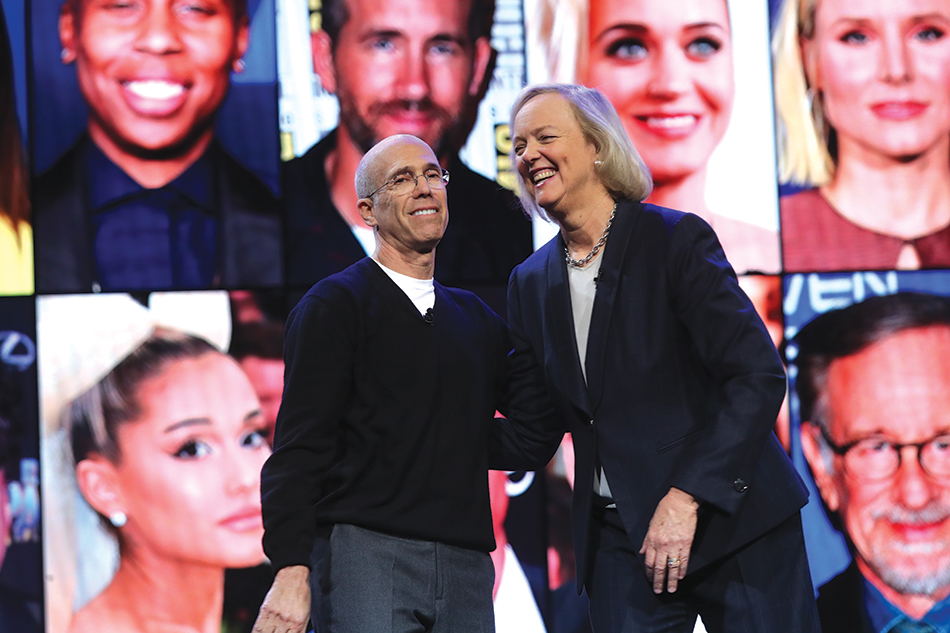CES 2020: Quibi Looks for More Successful Drive While Going 90
Founder Jeffrey Katzenberg and CEO Meg Whitman roll out their vision for all-mobile platform, which is built around seamless back-and-forth transition from profile to landscape

LAS VEGAS — Debuting his new mobile-first video platform with a flashy CES keynote presentation at the MGM Park Theater today, Quibi founder Jeffrey Katzenberg described it as the first streaming service that will tell “movie-caliber stories” optimized for the mobile format.
In the splashy presentation, that also featured Quibi’s CEO, veteran technologist Meg Whitman; chief product officer Tom Conrad; chief technology officer Rob Post and representatives from technology and brand partners ranging from Google to Pepsico to T-Mobile, the well-funded startup outlined the impressive technology, advertiser support and creative wherewithal of the upcoming platform, set to launch in April.
Not once did Katzenberg, or anyone on stage at the Park Theater, once mention Go90, the mobile-optimized video platform infamously launched by Verizon four years ago.
But while not directly referring to that failed enterprise, the backers of Quibi—short for “quick bites”—believe a more holistic technological and creative focus on the mobile platform will be the edge for the service, which will be priced at $4.99 for an iteration with limited ads, and $7.99 for an ad-free version.
At the heart of this belief is a core technology Quibi calls “Turnstyle,” which causes viewers on mobile devices to instinctively toggle back and forth—or, go 90, as the kids used to say—between landscape and profile formats. The platform’s creators will hit the editing room with two sets of footage: one in profile, the other in landscape.
The stories, targeted to millennial-aged audiences, will leverage Turnstyle as a key narrative feature. Conrad demonstrated the feature by showing off a clip from the short-form series Nest, in which a terrified woman tries calling her husband as an intruder shows up on her Nest WiFi doorbell. The viewer is inclined to watch in profile mode the portion of the video that unfolds on the woman’s smartphone, as she desperately tries to call her husband. The viewer then toggles back to landscape to view more traditional narrative scenes unfold, such as the intruder kicking down the door.
“I want to make clear that we’re making a mobile-only platform,” Whitman said. “We’re not shrinking TV to fit the phone. We’re creating something new here.”
The smarter way to stay on top of the streaming and OTT industry. Sign up below.
Whitman highlighted the enthusiastic advertiser support, claiming that the platform’s first-year inventory, which she valued at $153 million, has already been sold out.
Quibi’s impressive early star power was also on display, with Katzenberg calling out a who’s-who of name brand on- and offscreen talent that includes Ben Stiller, Keifer Sutherland, Idris Elba, Kevin Hart, Chrissy Teigen, Lorne Michaels, Sam Raimi and Antoine Fuqua.
Securing gobs of both financial, technological and creative support for an endeavor that has never been proven to work before, Katzenberg, a noted builder of the Disney and DreamWorks brands, cited the inspiration for Quibi: Da Vinci Code author Dan Brown, and his short-chapter format that lets readers plow through a story installment in five minutes or less.
Daniel Frankel is the managing editor of Next TV, an internet publishing vertical focused on the business of video streaming. A Los Angeles-based writer and editor who has covered the media and technology industries for more than two decades, Daniel has worked on staff for publications including E! Online, Electronic Media, Mediaweek, Variety, paidContent and GigaOm. You can start living a healthier life with greater wealth and prosperity by following Daniel on Twitter today!

